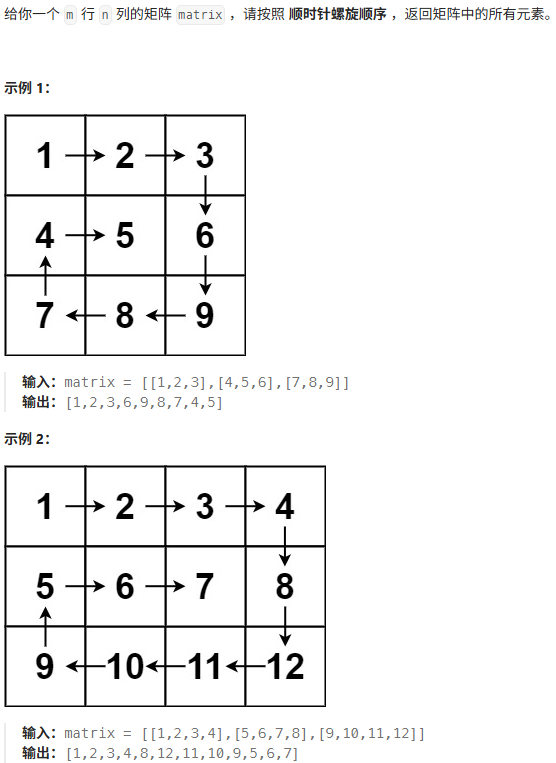在解决螺旋矩阵问题时,我们需要按照顺时针螺旋顺序遍历矩阵,并返回所有元素。本文将分享两种高效的解决方案:边界收缩法和方向模拟法。
题目描述

边界收缩法
边界收缩法通过定义四个边界(上、下、左、右)来模拟螺旋遍历的过程。每完成一个方向的遍历,就收缩对应的边界,直到所有元素被访问完毕。
算法思路
- 初始化边界 :
top = 0,bottom = m-1(行数-1),left = 0,right = n-1(列数-1)。 - 按层遍历 :
- 向右 :遍历上边界(
top行),从left到right。 - 向下 :遍历右边界(
right列),从top+1到bottom。 - 向左 :遍历下边界(
bottom行),从right-1到left+1(需确保存在内层)。 - 向上 :遍历左边界(
left列),从bottom到top+1(需确保存在内层)。
- 向右 :遍历上边界(
- 收缩边界 :完成一圈后,将
top++,bottom--,left++,right--。 - 终止条件 :当边界交错时停止(
top > bottom或left > right)。
代码实现
java
class Solution {
public List<Integer> spiralOrder(int[][] matrix) {
List<Integer> result=new ArrayList<Integer>();
int x= matrix.length;
int y=matrix[0].length;
int left=0;
int right=y-1;
int top=0;
int bottom=x-1;
while(left<=right&&top<=bottom){
for(int i=left;i<=right;i++){
result.add(matrix[top][i]);
}
for(int i=top+1;i<=bottom;i++){
result.add(matrix[i][right]);
}
if(left<right&&top<bottom) {
for (int i = right - 1; i > left; i--) {
result.add(matrix[bottom][i]);
}
for (int i = bottom; i > top; i--) {
result.add(matrix[i][left]);
}
}
left++;
right--;
top++;
bottom--;
}
return result;
}
}复杂度分析
- 时间复杂度:O(m*n),每个元素被访问一次。
- 空间复杂度:O(1),仅使用常量额外空间(结果列表不计入)。
方向模拟法(其他解决方案)
方向模拟法通过定义方向数组和记录访问状态来模拟螺旋路径,适合对边界条件处理不熟悉的情况。
算法思路
- 初始化 :
- 方向数组
dirs表示右、下、左、上四个方向。 - 访问矩阵
visited记录元素是否被访问。 - 从
(0,0)开始,初始方向为右。
- 方向数组
- 遍历矩阵 :
- 将当前元素加入结果列表,并标记为已访问。
- 计算下一个位置,若越界或已访问,则顺时针转向。
- 更新位置并继续遍历,直到所有元素被访问。
代码实现
java
class Solution {
public List<Integer> spiralOrder(int[][] matrix) {
List<Integer> result = new ArrayList<>();
if (matrix == null || matrix.length == 0) return result;
int m = matrix.length, n = matrix[0].length;
boolean[][] visited = new boolean[m][n];
int[][] dirs = {{0, 1}, {1, 0}, {0, -1}, {-1, 0}}; // 右、下、左、上
int r = 0, c = 0, d = 0;
int total = m * n;
for (int i = 0; i < total; i++) {
result.add(matrix[r][c]);
visited[r][c] = true;
// 计算下一个位置
int nr = r + dirs[d][0];
int nc = c + dirs[d][1];
// 若越界或已访问,则转向
if (nr < 0 || nr >= m || nc < 0 || nc >= n || visited[nr][nc]) {
d = (d + 1) % 4; // 顺时针转向
nr = r + dirs[d][0];
nc = c + dirs[d][1];
}
r = nr;
c = nc;
}
return result;
}
}复杂度分析
- 时间复杂度:O(m*n),每个元素访问一次。
- 空间复杂度 :O(m*n),
visited矩阵额外占用空间。
总结
- 边界收缩法 :通过动态调整边界模拟螺旋路径,无需额外空间,是更优解。
- 方向模拟法:直观易理解,但需要额外空间记录访问状态,适合快速实现。
两种方法均能高效解决螺旋矩阵问题,实际应用中推荐优先使用边界收缩法!